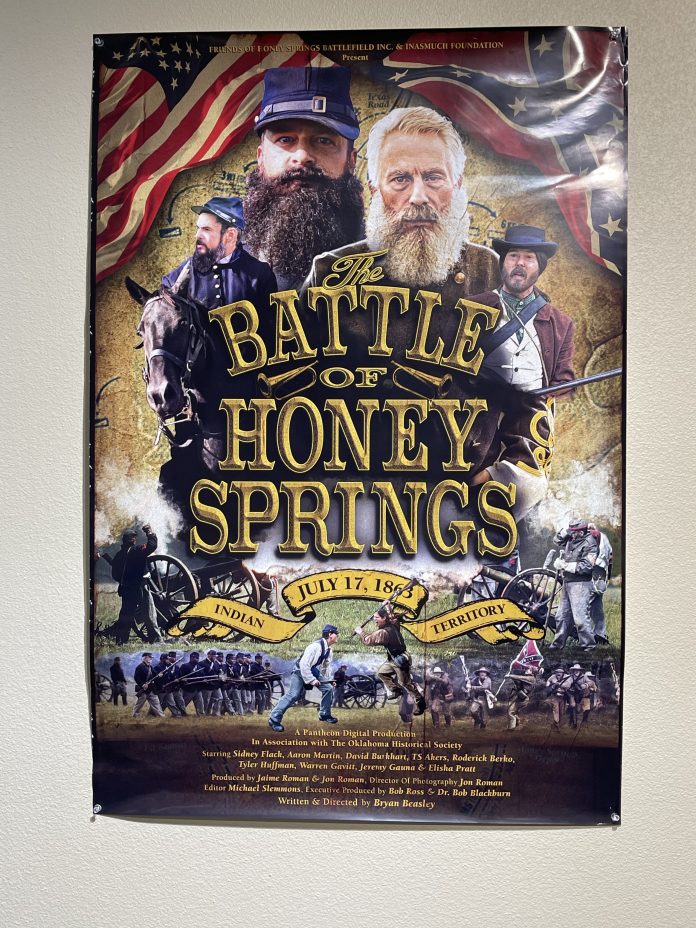GAVEL GAMUT
By Jim Redwine
www.jamesmredwine.com
(Week of 28 July 2025)
THE BATTLE OF HONEY SPRINGS
Just as my public-school education failed to lead one to analogies involving America’s Manifest Destiny and slavery or the genocide of indigenous peoples, it often concentrated on the perceived benefits bestowed on both Negroes and first Americans by their white governors. Black and Indian contributions to our shared history were generally omitted or diminished. My knowledge of these significant influences on America’s unrelenting march from the Atlantic to the Pacific and from Canada to the Gulf of Mexico came mostly by coincidence. Such was the case when Peg and I heard about the Civil War Battle of Honey Springs.
Our first exposure to this most important Civil War conflict in Indian Territory came from a brief mention of it on PBS just this past spring. We researched it, on the Internet of course, and discovered it occurred July 17, 1863 near Checotah, Oklahoma which is only about an hour and a half from our home in Osage County, Oklahoma. It was readily apparent why this “Gettysburg of the West” is barely a blip in our nation’s consciousness. Although the battle determined whether the Union or Confederate forces would control the vital Texas Road that protected supply lines from Mexico to Kansas right through the heart of Indian Territory (Oklahoma), the soldiers who fought the desperate fight consisted of white, Black and several tribes of Native Americans who supported both sides.
In fact, the 1st Kansas Colored Infantry was instrumental in the battle for the Union and several Black soldiers fought alongside Creek, Choctaw, Cherokee, Seminole and Chickasaw warriors who had divided loyalties for both the North and the South. The commander of the 1st Kansas Colored Infantry was the only white man for that brigade.
Honey Springs, the location of this battle involving several thousand soldiers for each side, was named for a gigantic beehive that was attached to a large oak tree near the running spring. As with much of military history the outcome of the battle hinged on the weather. The Southern forces were in that location because the commander of Southern Forces in the Indian Territory, Maj. Gen. William Steele, ordered the capture of fairly nearby Ft. Gibson. Steele dispatched troops under Brig. Gen. Douglas Cooper to meet up with other Confederate troops under the command of Gen. Cabell whose men were about 25 miles from Honey Springs. His soldiers did a forced march through rain, mud and swollen streams but arrived late to the battle between Cooper’s and Union Gen. James G. Blunt’s soldiers. The fight was already a Union victory and the Texas Road as well as Ft. Gibson remained in Union control throughout the remainder of the Civil War.
History may normally be written by the victors but America’s history has usually been written by white people east of the Mississippi River. Such is the case of Honey Springs. Some Civil War analysts posit this battle crippled any chance the Confederacy could recover from U.S. Grant’s victorious siege of Vicksburg, Mississippi that caused Southern Gen. John Pemberton to surrender to Grant on July 04, 1863, two weeks before the Union victory at Honey Springs.
Vicksburg secured Union control of the Mississippi River and the South’s loss at Honey Springs prevented the South from circumventing the Mississippi via the Texas Road. Gen. Cooper blamed the loss on inferior gunpowder that the South had to purchase from Mexico. Also, the rain made the inferior powder even more defective.
But what I suggest I and other Americans should have learned is the service of Black and First American conflicting loyalties and the reasons for them. Also, it should be noted that the “Gettysburg of the West” was and is deserving of a place in our country’s Volksgeist. If you are prone to Civil War reenactments, Gentle Reader, the Battle of Honey Springs reenactment will take place after the intense Oklahoma July heat is more kind to woolen uniforms on November 8, 2025. You can find more information about the battle and the reenactment weekend activities online at www.okhistory.org.
For more Gavel Gamut articles go to www.jamesmredwine.com





